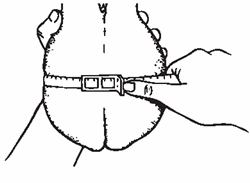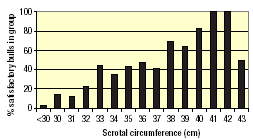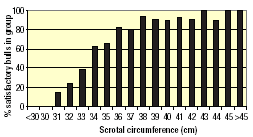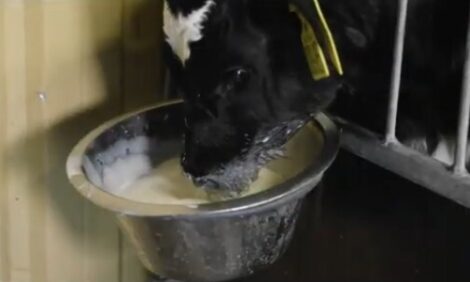



Reproductive Fertility in Herd Bulls
By George Perry, Beef Reproduction and Management Specialist, Julie Walker, Beef Specialist and Russ Daly. Published in the South Dakota State University, Extension Extra.
Introduction
Herd bulls have a large influence on many aspects of beef operations, especially an operation’s profitability. For example, percent calf crop weaned is the single most important factor influencing profitability, and the number of cows bred during the breeding season plays the largest role in percent calf crop weaned. Therefore, an operation’s profitability is directly tied to the herd bull’s breeding capability. In addition, herd bulls supply half of the genetics to all the calves he sires; therefore, bull selection can be the most powerful method of genetic improvement in the herd. Herd bulls also influence overall herd fertility more than any other single animal; the loss of fertility by a bull can mean the potential loss of an entire calf crop. For the above reasons, and because greater than 90% of the beef cows in the United States are bred by natural service, it is important that bulls be managed to optimize breeding performance.
There are several factors that influence bull fertility. First, the bull must have developed properly and have reached puberty to be fertile. Second, the bull’s physical characteristics, such as scrotal circumference, mating ability, and semen quality, play a role in his fertility. Third, the bull’s libido and social dominance influence his fertility.
Puberty and bull development
The most commonly used definition of puberty in bulls is when an ejaculate collected via electroejaculation contains a minimum of 50 x 106 total sperm with at least 10% progressive motility. Feeding different energy levels of feed can affect the age and weight at which puberty occurs. High levels of energy can increase weight, height, and scrotal circumference without affecting age at puberty or first mating —indicating that nutrition can affect bull development without affecting sexual development. In addition, highly fitted or excessively conditioned bulls may fatigue rapidly, resulting in fewer cows conceiving during the breeding season. Ideally, bulls should be in a condition score 6 (on a 9-point system), since bulls normally lose about 100 to 200 pounds (1.0 to 2.5 condition scores) during the breeding season. This weight loss should come from energy stored as fat (condition) rather than from muscle tissue, and this is especially important for young bulls because they are still growing.
Since most bulls are purchased, what is the best nutritional management for the prebreeding season period? The length of the prebreeding period for purchased bulls may vary and is dependent on when the bulls are purchased or delivered. When bulls are delivered or purchased, first assess the condition of the bull(s) and make decisions based on the desired condition wanted at breeding time. Because young (yearling) bulls are still growing, turning the bulls out to “rough it” is not adequate. A diet with adequate energy and protein content needs to be developed in order to continue the bull’s growth and development. Diets can vary from forage-based with low levels of grain to energy-dense diets. A good mineral program is also critical for optimum reproductive performance.
Highly fitted (over-conditioned) bulls should be gradually stepped down in condition to avoid nutritional disorders and adverse effects on semen production. Place bulls on a diet similar to the previous rations, but limit intake to 60 to 70% of their previous intake. Remove 10% of the grain per week until the desired level is achieved. Replace grain with light, bulky feeds such as forages.
Diets with extremely low energy content can delay puberty and potentially impair sperm production. In addition, bulls that are undernourished at a young age may never develop appropriately when compared to bulls that are properly fed (VanDemark et al. 1964).
The age and weight at which puberty occurs varies greatly among breeds and the level of nutrition during development. Research with various breeds suggests that a practical indication of eminent puberty is when scrotal circumference is between 27 and 29 cm (Lunstra et al. 1978). Simply because a bull has reached puberty and can produce semen does not necessarily mean he is highly fertile. Sperm quality and quantity continues to increase for several months after the initiation of semen production. Only about 35, 60, and 95% of 12-, 14-, and 16-monthold bulls, respectively, are reproductively mature and produce good quality semen (Barth 2000).
Fertility factors evaluated in a BSE
Breeding Soundness evaluation (BSe). The American Society for Theriogenology has developed minimum guidelines for a bull to pass a breeding soundness evaluation. A breeding soundness evaluation includes a physical examination, the measurement of scrotal circumference, and an evaluation of semen quality. To successfully complete a breeding soundness evaluation, a bull must have at least 30% sperm motility, 70% normal sperm morphology, and a minimum scrotal circumference based on age (table 1; Chenoweth et al. 1992). Bulls meeting the preceding minimum requirements are classified as satisfactory potential breeders. If a bull does not pass one of these tests, he is either classified as a classification deferred (meaning it is recommended that the bull be tested again) or as an unsatisfactory potential breeder. Bulls should be tested approximately 4 to 6 weeks prior to the breeding season. This time period allows for time to either retest bulls when unsatisfactory results are obtained or to find a replacement herd bull.
| Table 1. Minimum scrotal circumference requirements for bulls to successfully pass a breeding soundness evaluation based on the age of bulls. (Chenoweth et al. 1992) | |||||
|
Minimum scrotal circumference requirements based on age
|
|||||
|---|---|---|---|---|---|
|
Age in months
|
< 15
|
> 15 < 18
|
> 18 < 21
|
> 21 < 24
|
> 24
|
|
Scrotal circumference (cm)
|
30
|
> 31
|
> 32
|
> 33
|
34
|
Mating Ability. The physical examination portion of a breeding soundness evaluation determines a bull’s mating ability. Mating ability can be described as the physical capabilities needed to successfully breed a cow. A bull must be able to see, smell, eat, and move normally to successfully breed cows. The physical examination closely scrutinizes a bull’s eyes, teeth, feet, legs, and nutritional level (evaluated by body condition score). Any disease or injury that affects joints, muscles, nerves, bones, or tendons may cause a bull to be structurally unsound. In addition to structural unsoundness, diseases or injuries to the penis or prepuce can result in an inability to breed via natural service. These abnormalities will only be detected either by careful examination or by observing an attempted mating with a cow. A bull that has high-quality semen but is unable to physically breed cows is unsatisfactory for natural service.
Scrotal circumference. What does scrotal circumference tell you? As scrotal circumference increases, so does the daily production of high-quality sperm. There is also a positive genetic correlation between a sire’s scrotal circumference and the scrotal circumference of his sons; this indicates that bulls with a larger scrotal circumference will likely sire sons with larger scrotal circumference. For a sire’s daughters, there are both positive and negative genetic correlations for scrotal circumference. For the pregnancy rate of his daughters, there is a positive correlation, while for the daughters’ age at puberty, there is a negative correlation. This means that daughters of bulls with large scrotal circumferences should reach puberty at younger ages, be more likely to be cycling by the beginning of the breeding season, and be more likely to become pregnant early in the breeding season.
 |
| Figure 1. Scrotal circumference is measured by holding the testicles to the bottom of the scrotal sack, placing the tape around the widest point, and measuring the circumference. |
How do you measure scrotal circumference? There are two commonly used methods for measuring scrotal circumference: 1) a scrotal measuring tape and 2) the Coulter scrotal measuring tape. The scrotal measuring tape is a manual tape, whereas the Coulter is a spring-loaded tape that constricts around the scrotum. Scrotal circumference is measured by placing a measuring tape around the scrotum at the widest point and measuring the circumference of the scrotum (see fig. 1). A scrotal circumference measurement is an indirect estimate of the mass of testicular tissue; moreover, the amount of testicular tissue is directly related to sperm quantity and quality. Studies on 1944 bulls of various breeds and ages indicated that as scrotal size increased the probability of a bull passing a breeding soundness evaluation also increased (Cates 1975; figs. 2 and 3). Additionally, bulls with small scrotal circumference at one year of age tended to have small scrotal circumference at two years of age.
 |
| Figure 2. Percentage of bulls <2-years old having satisfactory semen quality in each scrotal circumference size group (Adapted from Cates, 1975). |
Semen Quality. Semen quality includes ejaculate volume, sperm cell motility, and sperm cell morphology. It is important to remember that substandard nutrition, extreme environmental temperatures, and disease can reduce semen quality, and the quality of semen from a single bull may change over time.
Sperm motility is calculated by evaluating the percentage of spermatozoa in a sample ejaculate that have progressive (headfirst) movement. This is calculated by placing a drop of semen on a microscope slide and determining at 100x magnification the number of spermatozoa with forward (headfirst) movement compared to sperm with other than forward progression.
 |
| Figure 3. Percentage of bulls >2-years old having satisfactory semen quality in each scrotal circumference size group (Adapted from Cates, 1975). |
Sperm morphology in a sample ejaculate is calculated by evaluating the percentages of normal spermatozoa and sperm with primary and secondary abnormalities. Primary abnormalities originate in the testis during spermatogenesis. Secondary abnormalities originate in the epididymis, during sperm transport, or with handling of the sperm. It is important to remember that primary and secondary abnormalities refer to the origin of the defect and not to the severity of the defect. Therefore, both primary and secondary abnormalities are equally important when evaluating sperm quality.
Sperm morphology influences pregnancy rates. Bulls with less than 20% abnormal sperm elicit greater pregnancy rates compared to other bulls (Wiltbank and Parish 1986; table 2). Therefore, selection of bulls with greater than 80% normal sperm can increase overall pregnancy rates in a herd.
| Table 2. Bulls were selected randomly or had ¡Ý80% normal sperm cells. All bulls had a scrotal circumference > 2 cm and successfully passed a breeding soundness evaluation (Wiltbank and Parish 1986). | ||||
| Year 1 | Year 2 | |||
|---|---|---|---|---|
| Random Group | >80% Normal Sperm | Random Group | >80% Normal Sperm | |
| Cows Exposed | 655 | 675 | 1282 | 808 |
| # of bulls | 26 | 27 | 51 | 33 |
| # pregnant | 571 | 656 | 1179 | 769 |
| % pregnant | 87% | 93% | 85% | 90% |
| % pregnant | 6% | 5% | ||
Is a single BSE valid for the life of the bull? Sperm production is a continuous process. However, a breeding soundness evaluation is conducted at a specific point in time and measures the sperm production at that specific time. Therefore, the results of a breeding soundness exam may change over time. In a study conducted at the University of Missouri, out of 34 young bulls (< 2 years) that failed their first breeding soundness evaluation, 26 successfully passed a second breeding soundness evaluation and were classified as satisfactory potential breeders (Elmore et al. 1975). It has been shown that semen quality in young bulls can improve for up to 16 weeks following puberty.
However, it is also true that a bull that successfully passes an initial breeding soundness evaluation can fail a subsequent evaluation. It is important to realize that the results of a single breeding soundness evaluation are not valid for the life of a bull, and testing a bull annually, usually a month to prior to the breeding season, is recommended. Many factors can affect sperm production, but four of the main factors that can decrease sperm production are injury, disease, fever, and extreme environmental conditions. Injury to the penis or testis can also result in infertility in bulls.
The future of bull fertility testing. Research is being conducted to identify the characteristics of semen that influence fertility rates. The ability of sperm to become capable of fertilizing an oocyte, the ability of sperm to bind an oocyte, and the ability of sperm to penetrate the oocyte all influence a bull’s fertility. Research is also underway to develop tests that will more accurately determine the fertility of individual bulls. Hopefully, we will eventually be able to predict the fertility of individual bulls by examining either a semen or a DNA sample.
Fertility factors not evaluated in a BSE Libido. Libido refers to the desire to mate. Libido is thought to be a highly inherited trait, with heritability ranging as high as 0.59. There is more variation in libido between sons of different sires than between sons of the same sire. It is important to remember that scrotal circumference, semen quality, and mating ability (evaluated in a BSE) are not related to libido. Therefore, a bull that passes a breeding soundness evaluation may have poor libido, or a bull with good libido may fail a breeding soundness evaluation.
Libido has positive effects on pregnancy rate and can influence the success of an entire breeding season. For this reason it is important to evaluate a bull’s desire to mate prior to the start of breeding season. This can be done by placing a bull in a pen with an estrous female and recording the bull’s eagerness to mate over a 5-minute period. A bull’s eagerness can range from no sexual interest to successfully mating with the female. Libido can be more practically evaluated by closely watching a bull after introducing him to a cow herd. The use of bulls with poor libido will result in lower herd pregnancy rates, due to the failure of the bulls in detecting and inseminating cows in estrus.
Male-to-Female Ratio. Since variations exist between bulls in their desire to mate (libido), recommendations for bull-to-cow ratios range from 1:10 up to 1:60. However, practical bull-to-cow ratios vary greatly depending on the capability of individual bulls and the situation they are placed in (e.g., synchronized or nonsynchronized herds). Bull age also affects bull-to-cow ratios. Yearling bulls have a lower serving capacity than older bulls. Therefore, it is important to remember that young bulls should be utilized at a lower bull-to-cow ratio than older bulls. No differences were detected between a bull to female ratio of 1:25 and 1:60 for estrous detection or pregnancy rates in the first 21 days of the breeding season, provided the bulls were mature, highly fertile, and had large scrotal circumferences (Rupp et al. 1977).
Individual 2- and 3-year-old bulls with high reproductive capacity have been used in nonsynchronized single-sire breeding groups with bull-to-cow ratios of 1:60 with no decrease in estrous detection or fertility (Chenoweth 1997). However, when multiple sires are used on a single group of females, additional bulls will be required (because several bulls will breed the same cow). In addition, when cows are synchronized and bred by natural service, greater pressure is placed on the herd bull. Therefore, additional bulls will be needed to breed the same number of cows (when compared to the number of bulls needed to breed nonsynchronized cows). When used on synchronized cows, and provided the bulls were mature, highly fertile, and had large scrotal circumferences, no difference was detected between a bull-to-female ratio of 1:16 and 1:25 (Healy et al. 1993).
Maximum bull-to-cow ratios will vary depending on the mating ability, semen quality, and libido of individual bulls. Bull-to-female ratios can usually be increased in single-sire breeding groups; however, bulls should be observed closely during the breeding season to ensure that they continue to mate successfully. Poor performance of a bull in a single-sire breeding group will affect the pregnancy rate of that group.
Social Dominance. A definite social ranking develops among bulls, and this ranking may affect the number of cows a given bull will service in a multiple-sire herd (table 3). Livestock managers must be aware of these relationships to ensure normal breeding rates. For example, a dominant bull with poor semen quality or low libido could reduce pregnancy rates for an entire herd, even when more fertile subordinate bulls are present.
| Table 3. Percent calf crop sired by individual sires in multiple sire pastures (Adapted from Lehrer et al. 1977). | |||||
| Percent Calf Crop Sired | |||||
|---|---|---|---|---|---|
| Percent Calf Crop Sired | Pasture 1 | Pasture 2 | Pasture 3 | Pasture 4 | Pasture 5 |
| Bull 1 | 30% | 34% | 44% | 92% | 75% |
| Bull 2 | 21% | 29% | 18% | 3% | 25% |
| Bull 3 | 12% | 21% | 16% | 3% | 0% |
| Bull 4 | 10% | 6% | 4% | ||
| Bull 5 | 9% | 4% | 4% | ||
| Bull 6 | 9% | 1% | 4% | ||
| Bull 7 | 5% | 1% | 2% | ||
| Bull 8 | 2% | ||||
| Bull 9 | 2% | ||||
| Bull 10 | 0% | ||||
| Number of Calves born | 73 | 64 | 43 | 28 | 32 |
A bull’s seniority is the major factor influencing its social ranking; the dominant bull in a breeding cadre is likely to be an older bull (Chenoweth 1997). Therefore, it is important not to introduce a young (yearling) bull into a herd with an older, more mature bull. Introducing young bulls into a herd with an older bull can be avoided by separating cows into single-sire breeding groups. In multiple-sire breeding groups, multiple bulls tend to breed the same sexually responsive females. This leads both to females being bred by more than one bull and to an increased risk of bull injury.
Conclusion
Since reproductive traits are not highly heritable, greater selection intensity is required to achieve genetic improvement. Selection intensity for female reproductive traits is usually low, as selection of replacement females in commercial herds is usually based on age or weight, not on reproductive performance. As a result, to achieve the desired level of genetic improvement, greater selection intensity is required in selection of herd bulls. Structurally sound bulls with a large scrotal circumference and high semen quality should be selected as herd sires. Moreover, it is important to remember that the semen quality of an individual bull changes over time, and libido and mating ability should be evaluated periodically.
References
Barth, A. D. 2000. Bull breeding soundness evaluation. 2nd ed. Western Canadian Association of Bovine Practitioners.
Cates, W. F. 1975. Observations on scrotal circumference and its relationship to classification of bulls. Proc. Ann. Mtng. Soc. for Theriogenology. Cheyenne, WY. pp. 1–19.
Chenoweth, P. J., J. C. Spitzer, and F. M. Hopkins. 1992. A new bull breeding soundness evaluation form. Proc. Ann. Mtng. Soc. for Theriogenology San Antonio, TX. pp. 63–71.
Chenoweth, P. J. 1997. Bull libido/serving capacity. Vet. Clin. North Amer. Food Anim. Prac. 13:331–344. Elmore, R. G., C. J. Bierschwal, C. E. Martin, and R. E. Youngquist. 1975. A summary of 1127 breeding soundness examinations in beef bulls. Theriogenology. 3:209–218.
Healy, V. M., G. W. Boyd, P. H. Gutierrez, R. G. Mortimer, and J. R. Piotrowski. 1993. Investigating optimal bull:heifer ratios required for estrous-synchronized heifers. J. Anim. Sci. 71:291–297.
Lehrer, A. R., M. B. Brown, H. Schindler, Z. Holzer, and B. Larsen. 1977. Paternity tests in multisired beef herds by blood grouping. Acta Vet. Scand. 18:433–441.
Lunstra, D. D., J. J. Ford, and S. E. Echternkamp. 1978. Puberty in beef bulls: hormone concentrations, growth, testicular development, sperm production, and sexual aggressiveness in bulls of different breeds. J. Anim. Sci. 46:1054–1062.
Rupp, G. P., L. Ball, M. C. Shoop, and P. J. Chenoweth. 1977. Reproductive efficiency of bulls in natural service: Effects of male to female ratio and single- vs multiple- sire breeding groups. J Am Vet Med Assoc 171: 639–642.
VanDemark, N. L., and R. E. Mauger. 1964. Effect of energy intake on reproductive performance of dairy bulls. I. Growth, reproductive organs, and puberty. J. Dairy Sci. 47:798–802.
Wiltbank, J. N., and N. R. Parish. 1986. Pregnancy rate in cows and heifers bred to bulls selected for semen quality. Theriogenology. 25:779–783.


